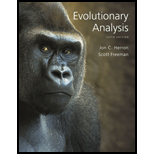
Look back at Figure 2.14d, which shows the two kinds of threespine sticklebacks that live in Paxon Lake. There used to be a similar limnetic/benthic pair in Enos Lake (see Hendry et al. 2009). However, recent studies have revealed that the two forms in Enos Lake have recently merged into a single highly variable population. How does this bear on the claim that the two forms in Paxton Lake are different species? How does it bear on the claim that varying degrees of divergence among stickleback populations provide evidence for

Want to see the full answer?
Check out a sample textbook solution
Chapter 2 Solutions
Evolutionary Analysis (5th Edition)
Additional Science Textbook Solutions
HUMAN ANATOMY
Microbiology Fundamentals: A Clinical Approach
Human Physiology: An Integrated Approach (8th Edition)
Physics for Scientists and Engineers: A Strategic Approach, Vol. 1 (Chs 1-21) (4th Edition)
Campbell Essential Biology (7th Edition)